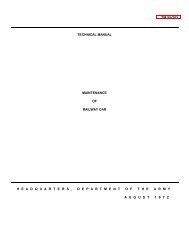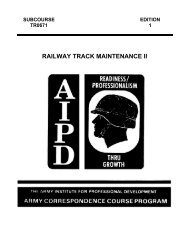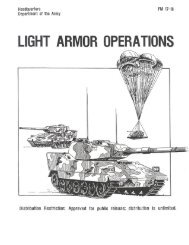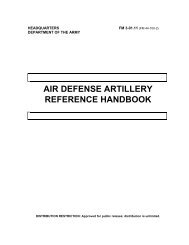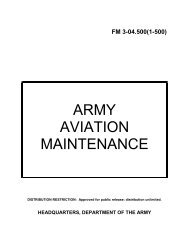fm 44-100 us army air and missile defense operations
fm 44-100 us army air and missile defense operations
fm 44-100 us army air and missile defense operations
You also want an ePaper? Increase the reach of your titles
YUMPU automatically turns print PDFs into web optimized ePapers that Google loves.
FM <strong>44</strong>-<strong>100</strong><br />
7-10<br />
Movement officers m<strong>us</strong>t be proficient in planning their support requirements<br />
<strong>and</strong> completing the necessary transportation support requests <strong>and</strong> movement<br />
bids. FM 55-10 provides detailed guidance on procedures for obtaining<br />
transportation support <strong>and</strong> conducting movement planning.<br />
SUSTAINING SOLDIERS AND THEIR SYSTEMS<br />
7-48. The five elements of s<strong>us</strong>taining soldiers <strong>and</strong> their systems are personnel<br />
services, health services, field services, quality of life, <strong>and</strong> general supply<br />
support. During planning for future <strong>operations</strong>, the logistician identifies all<br />
the CSS organizations tasked to support subordinate units during the<br />
operation. Provisions should be made for buildup of medical <strong>and</strong> general<br />
supplies needed to s<strong>us</strong>tain the force throughout the operation.<br />
COMBAT SERVICE SUPPORT OPERATIONS<br />
7-49. CSS <strong>operations</strong> are planned <strong>and</strong> monitored by the G1 or S1 <strong>and</strong> G4 or<br />
S4 in the logistics readiness center (LRC). The S1 <strong>and</strong> S4 jointly man the<br />
LRC, which operates around the clock as a part of battalion <strong>and</strong> brigade<br />
TOCs. Within the LRC, CSS stat<strong>us</strong> of the force is maintained, as are the<br />
locations of all subordinate units <strong>and</strong> their supporting CSS units. Requisition<br />
<strong>and</strong> maintenance activities for critical materiel are closely monitored.<br />
MANNING<br />
7-50. The S4 is the logistics officer. He maintains equipment stat<strong>us</strong> <strong>and</strong><br />
coordinates with direct support units for contact team assistance <strong>and</strong><br />
equipment rep<strong>air</strong> or replacement. The logistics officer works closely with the<br />
battalion or brigade maintenance officer to coordinate maintenance of both<br />
system <strong>and</strong> conventional equipment. The S4 is also responsible for brigade or<br />
battalions supply actions. The logistics officer maintains stat<strong>us</strong> of all areas of<br />
supply, but foc<strong>us</strong>es on the adequacy of <strong>missile</strong>s, ammunition, fuel, food,<br />
water, <strong>and</strong> rep<strong>air</strong> parts.<br />
7-51. Personnel readiness management (PRM), personnel accounting <strong>and</strong><br />
strength reporting (PASR), casualty <strong>operations</strong> management (COM), <strong>and</strong><br />
replacement management are all critical personnel systems <strong>and</strong> functions<br />
which foc<strong>us</strong> on manning. The mission of the PRM system is to distribute<br />
soldiers <strong>and</strong> Army civilians to subordinate comm<strong>and</strong>s based on documented<br />
manpower requirements or authorization <strong>and</strong> the comm<strong>and</strong>er's priorities.<br />
Personnel readiness describes a state of wartime preparedness. PRM is a<br />
process for achieving <strong>and</strong> maintaining that state.<br />
7-52. The S1 m<strong>us</strong>t ensure that expeditio<strong>us</strong> <strong>and</strong> accurate casualty <strong>and</strong><br />
strength reporting continues <strong>and</strong> personnel replacements are processed<br />
quickly <strong>and</strong> efficiently. He m<strong>us</strong>t also ensure all soldiers receive mail, postal<br />
<strong>and</strong> financial services, <strong>and</strong> MWR services, regardless of the unit dispersion<br />
<strong>and</strong> complex support relationships inherent to <strong>air</strong> <strong>defense</strong> artillery units.<br />
7-53. The Army's PASR system accounts for soldiers <strong>and</strong> civilians; reports<br />
other strength-related information; <strong>and</strong> updates comm<strong>and</strong> databases at all<br />
levels. Information gained throughout PASR provides readiness <strong>and</strong><br />
personnel managers the details necessary to analyze personnel strength as a<br />
component of combat power.




